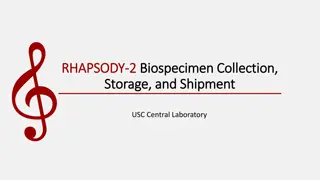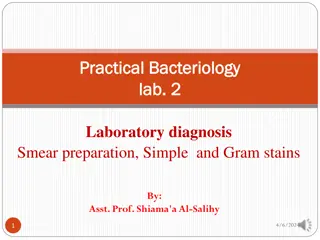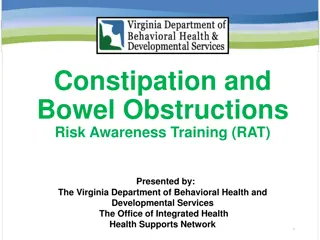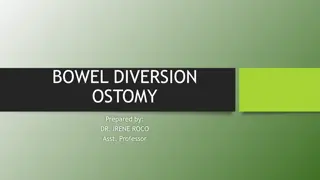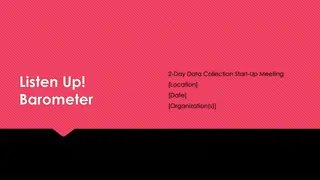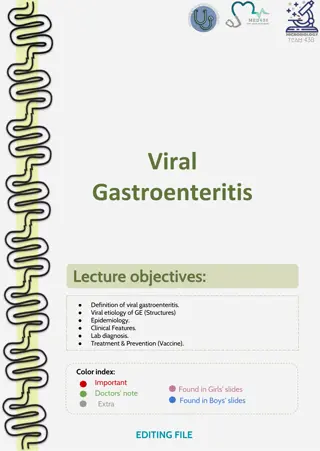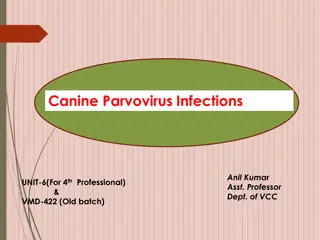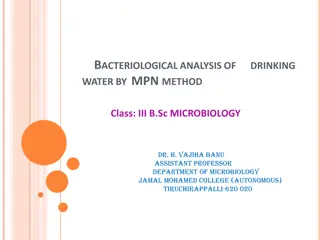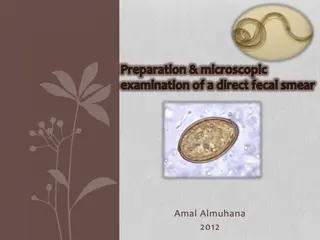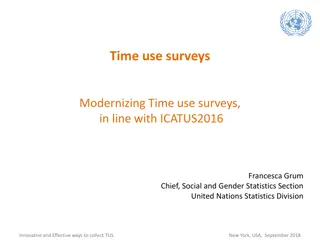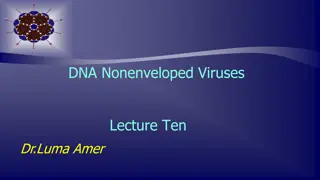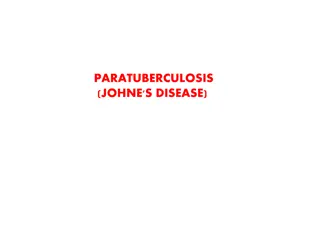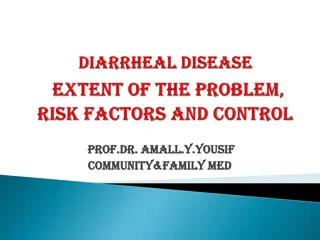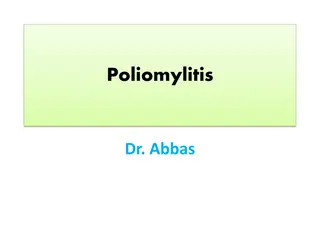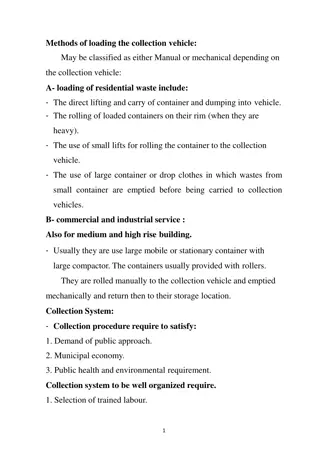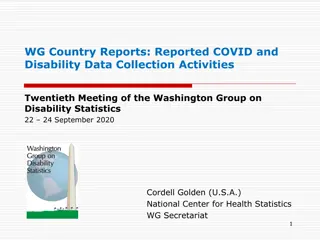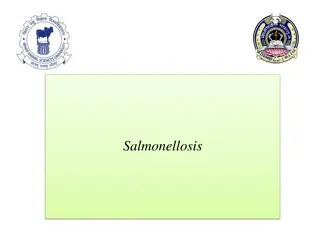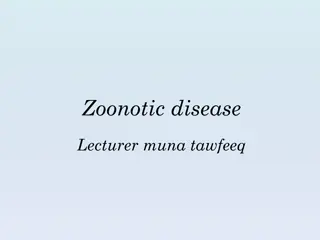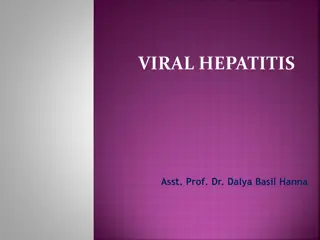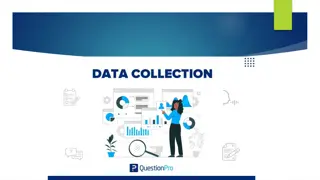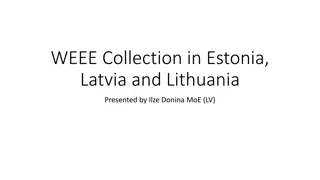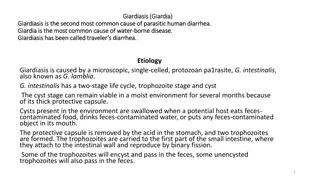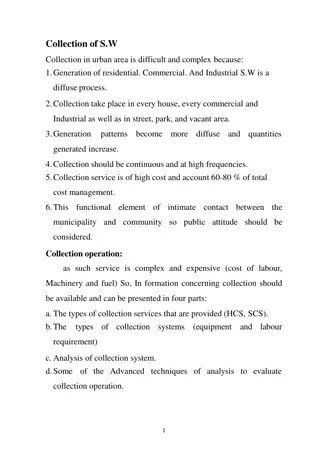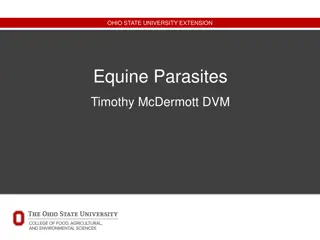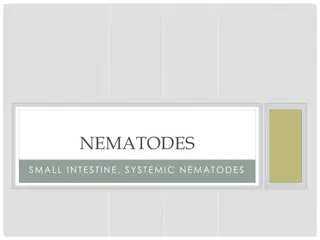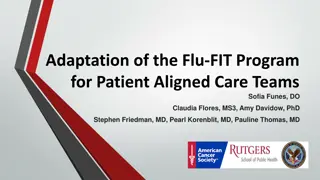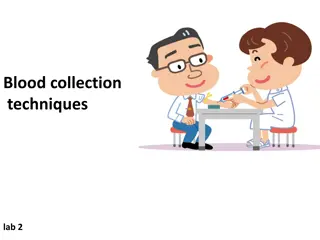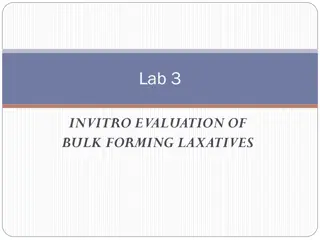Biospecimen Collection, Storage, and Shipment Overview at USC Central Laboratory
This overview covers the types of biospecimens collected, specimen collection schedule, supplies, protocols, and shipping instructions at the USC Central Laboratory. It includes details on whole blood collection for different assays, storage procedures, and shipment to USC Labs and Charles River Lab
0 views • 21 slides
Practical Bacteriology Laboratory Diagnosis and Sample Collection
This practical guide focuses on laboratory diagnosis steps in bacteriology, covering specimen collection, microscopic examination, culture tests, biochemical tests, serological tests, and molecular tests. Learn about various sample collection methods for urine, stool, swabs, sputum, pus, CSF, and mo
3 views • 23 slides
Understanding Constipation and Bowel Obstructions Risk
This training program by The Virginia Department of Behavioral Health and Developmental Services focuses on defining constipation, identifying causes and complications, recognizing bowel obstructions, and understanding signs and symptoms of fecal impaction. Caregiver recommendations and the roles of
0 views • 26 slides
Understanding Bowel Diversion Ostomy: Definition, Classification, and Management
Bowel diversion ostomy involves creating an opening in the gastrointestinal tract to divert and drain fecal material. This summary covers the definition, purpose, classification (permanent vs. temporary ostomies, types of intestinal ostomies), management, assessment, and changes associated with osto
0 views • 14 slides
Listen Up! 2-Day Data Collection Start-Up Meeting Overview
A comprehensive overview of the 2-day data collection start-up meeting for the Listen Up! project and Barometer. The meeting aims to equip participants with an understanding of project goals, data collection tools, feminist principles, and humanitarian response measures. Topics covered include core
0 views • 56 slides
Overview of Viral Gastroenteritis: Etiology, Epidemiology, Clinical Features, Diagnosis, and Treatment
Viral gastroenteritis is an inflammation of the gastrointestinal tract primarily affecting the stomach and small intestine, leading to symptoms like acute diarrhea and vomiting. It can be caused by various infectious agents such as Rotavirus, Adenovirus, Caliciviruses, Astrovirus, Coronavirus, Torov
1 views • 7 slides
Insights into Tyzzer's Disease: An Overview of a Bacterial Infection in Laboratory Animals
Tyzzer's disease is an acute bacterial infection affecting rodents and rabbits, caused by Clostridium piliforme. Discovered in 1917 by Ernest Tyzzer, the disease is characterized by necrotic lesions in the caecal mucosa, liver, and heart. Initially known as Bacillus piliformis, it was later renamed
2 views • 21 slides
Understanding Canine Viral Infection: A Comprehensive Overview
Canine Viral Infection, caused by canine parvovirus-2, is a highly contagious disease affecting dogs, especially puppies. The infection spreads through fecal-oral route and can lead to severe clinical signs like vomiting, diarrhea, and dehydration. The virus replicates in lymphoid tissues, affecting
0 views • 11 slides
Understanding Water-borne Diseases and Pathogens
Drinking contaminated water can lead to water-borne diseases, causing millions of deaths annually, especially in developing countries. Potable water is essential for health and development, as water-related diseases arise from inadequate water quality and poor sanitation practices. Various pathogens
1 views • 28 slides
Bacteriological Analysis of Drinking Water by MPN Method in Microbiology Class III
This study focuses on the bacteriological analysis of drinking water using the Most Probable Number (MPN) method in a microbiology class. The MPN method involves enumerating and identifying bacteria in drinking water samples through a series of tests including presumptive, confirmed, and completed t
0 views • 13 slides
Direct Fecal Smear Preparation and Microscopic Examination Procedure
Direct fecal smears are useful for quick screenings to detect intestinal parasites. This article outlines the preparation and microscopic examination procedure for direct fecal smears. It covers advantages, disadvantages, fecal collection methods, and steps for preparing and examining fecal smears u
0 views • 16 slides
Modernizing Time Use Surveys: Innovative Approaches for Efficient Data Collection
Explore innovative ways to modernize time use surveys for efficient data collection, addressing challenges like high respondent burden and low response rates. The article covers cost-effective methods, instrument requirements, data collection modes, and optimizing inputs and outputs. Various survey
0 views • 12 slides
Understanding the Transmission of Viruses: Routes and Implications
Viruses are intracellular parasites that require transmission to a new host to evade immune responses. This transmission process, whether through respiratory droplets, fecal-oral routes, or sexual contact, is crucial in the viral life cycle. Different modes of transmission, such as horizontal and ve
0 views • 11 slides
Understanding Adenoviruses: Structure, Replication, and Epidemiology
Adenoviruses, known for causing respiratory infections, have at least 41 serotypes categorized into 6 subgenera. Their structure includes 252 capsomeres, 240 hexons, and specific proteins for attachment. The replication involves virus attachment, penetration, uncoating, and transportation of viral D
0 views • 22 slides
Understanding Paratuberculosis (Johne's Disease) in Animals
Contagious and fatal, Paratuberculosis, or Johne's Disease, affects the small intestine of ruminants due to Mycobacterium avium subspecies paratuberculosis. It spreads through fecal-oral route, affecting animals' immunity, causing weight loss, decreased milk production, and diarrhea. The infection l
0 views • 14 slides
Understanding Feco-Oral Diseases and Diarrhea Transmission
Feco-oral diseases, primarily transmitted through the fecal-oral route, remain a significant global health concern, especially affecting children under 5 and the elderly. Diarrhea, characterized by WHO as three or more watery stools in 24 hours, poses a substantial burden, with infectious agents cau
0 views • 46 slides
Feline Nematode Infection in Annual Health Visit
Millie, a 4-year-old domestic shorthair cat, was found to have Toxocara cati infection during her routine annual health visit. She was asymptomatic, and the infection was detected through a fecal exam. The treatment plan includes using an FDA-approved drug and recommending a monthly parasite prevent
2 views • 11 slides
Understanding Data Collection and Analysis for Businesses
Explore the impact and role of data utilization in organizations through the investigation of data collection methods, data quality, decision-making processes, reliability of collection methods, factors affecting data quality, and privacy considerations. Two scenarios are presented: data collection
1 views • 24 slides
The Role of Poo in Care Team Dynamics: A Study on Stigma and Skillset in Care Homes
Research conducted by Leah Fullegar, a Research Associate, sheds light on how stigma around fecal incontinence is managed by care staff in care homes. Findings reveal skillset devaluation and challenges faced by care providers. The study discusses the importance of inclusivity and team cohesion in p
0 views • 6 slides
Poliomyelitis: A Comprehensive Overview of the Disease
Poliomyelitis, commonly known as polio, is caused by a non-enveloped, positive, single-stranded RNA virus belonging to the Picornaviridae family. Paralysis is the most severe consequence of polio infection, with transmission occurring through the fecal-oral route. The virus primarily infects the GI
0 views • 23 slides
Waste Collection Systems Overview and Best Practices
Waste collection systems can be classified as manual or mechanical based on the type of collection vehicle used. Residential waste loading methods include direct lifting, rolling of containers, and use of lifts. Commercial and industrial services typically utilize large mobile or stationary containe
0 views • 7 slides
Comprehensive Collection and Foreclosure Update by Michael R. Vieira, Esq.
As discussed by Michael R. Vieira, Esq. from Ashford & Wriston LLP, this collection and foreclosure update covers crucial aspects such as collections 101, decision-making processes, lawsuit timelines, judgment collection strategies, service member protections, common arguments, and more. The informa
0 views • 88 slides
Physiotherapy Support for Mothers with OASI - Expert Guidance and Rehabilitation
Providing specialized physiotherapy support for mothers experiencing Obstetric Anal Sphincter Injuries (OASI) is crucial for addressing immediate problems like pain, urinary or fecal incontinence, and more. With a focus on pelvic health, this approach involves reassurance, tailored pelvic floor musc
0 views • 12 slides
Data Collection on COVID and Disability by Washington Group
The Washington Group on Disability Statistics conducts data collection activities related to COVID and disability through annual country reports. These reports include information on recent and planned data collection efforts, surveys and censuses on disability, administrative records, and specific
0 views • 13 slides
Insights into the Kato and Miura Thick Smear Technique
In 1954, Kato and Miura introduced the cellophane thick-smear technique for direct fecal sampling, revolutionizing helminthic infection detection. This method evolved into the Kato-Katz technique, providing advantages like precise egg quantification but facing challenges with hookworm egg visualizat
0 views • 19 slides
Salmonellosis: Understanding the Disease and Its Implications
Salmonellosis is a bacterial infection caused by various serotypes of the Salmonella bacteria. The disease is transmitted through contaminated food, direct contact with infected animals, or the fecal-oral route in endemic areas. Typhoidal Salmonella serovars can lead to serious conditions like enter
0 views • 23 slides
Understanding Zoonotic Hepatitis A Virus Infections
Zoonotic hepatitis A virus infections primarily affect humans and nonhuman primates, with transmission occurring through fecal-oral route. This article delves into the reservoir, mode of transmission, clinical signs, and diagnosis of hepatitis A, shedding light on its impact on both species. Nonhuma
0 views • 22 slides
Understanding Viral Hepatitis: Causes, Types, and Clinical Symptoms
Viral hepatitis is caused by various hepatotropic viruses, including Hepatitis A, B, C, D, and E. This type of liver inflammation can manifest acutely or chronically, leading to symptoms such as jaundice, abdominal pain, nausea, and fatigue. Hepatitis A virus, in particular, is primarily transmitted
0 views • 36 slides
Understanding Data Collection Methods for Business Analysis
Data collection is essential for analyzing business performance and making informed decisions. Various data collection methods like primary and secondary data collection help evaluate outcomes and draw conclusions. Primary data includes raw information obtained firsthand, while quantitative methods
0 views • 15 slides
Understanding Health Risks in Reclaimed Water and Water Reuse
Exploring the microbial aspects of reclaimed water and wastewater reuse is crucial for public health. Pathogenic microorganisms present in wastewater, such as bacteria, viruses, and parasites, can lead to gastrointestinal and systemic illnesses in humans. Proper removal and inactivation of these pat
0 views • 25 slides
Overview of WEEE Collection in Baltic States
This presentation explores the WEEE (Waste Electrical and Electronic Equipment) collection practices in Estonia, Latvia, and Lithuania. It covers the targets set by the WEEE directive 2012/19/EU, the setup of collection systems, and the results achieved. The content delves into the minimum collectio
0 views • 19 slides
Understanding Giardiasis: Causes, Symptoms, and Prevention
Giardiasis, caused by the parasite Giardia intestinalis, is a common diarrheal illness in humans and animals. It spreads through fecal-oral transmission and can be highly contagious. Symptoms include diarrhea, nausea, cramps, and fatigue. Young children and those in certain risk groups are more susc
2 views • 9 slides
Challenges and Strategies in Solid Waste Collection in Urban Areas
Solid waste collection in urban areas is complex due to the diffuse nature of waste generation, varied collection locations, increased quantities of waste, high costs, and the need for continuous service. Different collection methods and systems such as curbside pick-up, alley service, set-out set-b
0 views • 5 slides
Understanding Equine Parasites: A Comprehensive Guide by Ohio State University Extension
Explore the intricate world of equine parasites with a detailed guide provided by Ohio State University Extension. Learn about internal and external parasites, common signs of infestation, fecal testing techniques, and specific types like strongyles and roundworms. Discover the importance of proper
0 views • 24 slides
Understanding Parasitic and Non-Parasitic Materials in Feces Examination
When examining feces for parasites, it's crucial to differentiate between parasitic material, non-parasitic material, and pseudoparasites. Recognizing parasite eggs and cysts based on their shape and size is essential for accurate identification. Additionally, being aware of non-parasitic materials
0 views • 7 slides
Understanding TMDL Development in Water Quality Management
Exploring the Total Maximum Daily Load (TMDL) development process for impaired streams, including definitions of TMDL, impaired streams, numeric criteria for pollutants like fecal coliform bacteria and selenium, and narrative criteria to protect aquatic ecosystems. The content covers the necessity o
1 views • 24 slides
Overview of Intestinal Nematodes: Ascaris lumbricoides and Strongyloides stercoralis
Intestinal nematodes, including Ascaris lumbricoides and Strongyloides stercoralis, are common parasitic infections affecting the small intestine. Ascaris is a roundworm with a global distribution, transmitted via fecal-oral route or flies, while Strongyloides is a threadworm primarily found in trop
0 views • 24 slides
Implementation of Flu-FIT Program for Patient Aligned Care Teams at East Orange VA
This study details the adaptation of the Flu-FIT Program to enhance colorectal cancer screening rates within patient aligned care teams at the Veterans Affairs (VA) Department. By linking influenza immunization with colorectal cancer screening using fecal immunochemical testing, the project aimed to
0 views • 10 slides
Comprehensive Guide to Blood Collection Techniques in Medical Investigations
Blood collection is a crucial process in medical investigations where blood is withdrawn from patients for analysis. Methods include arterial sampling, venipuncture, and fingerstick sampling, each serving specific purposes. Venous blood is preferred over arterial blood due to accessibility and ease
0 views • 10 slides
Understanding Bulk Forming Laxatives for Improved Digestive Health
Bulk forming laxatives are effective in relieving constipation by increasing fecal mass and stimulating peristalsis. They work by forming a gel-like substance in the intestines, keeping stool soft and hydrated. Adequate fluid intake is important while using these laxatives to avoid intestinal obstru
0 views • 13 slides
